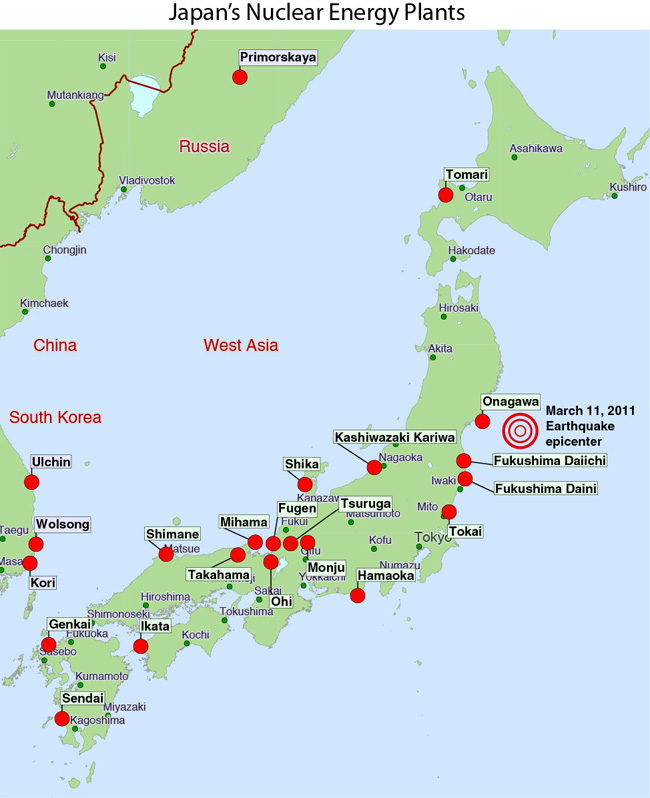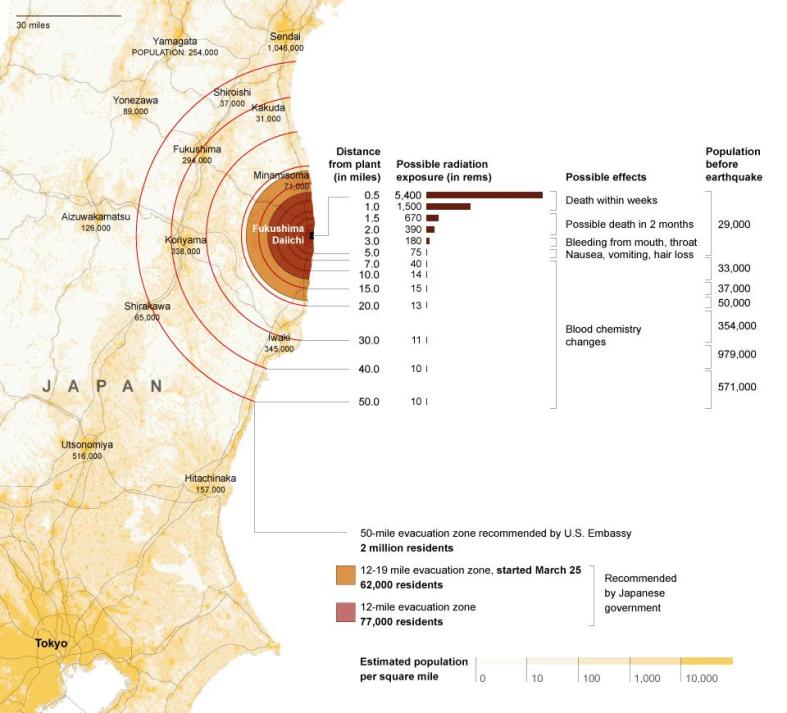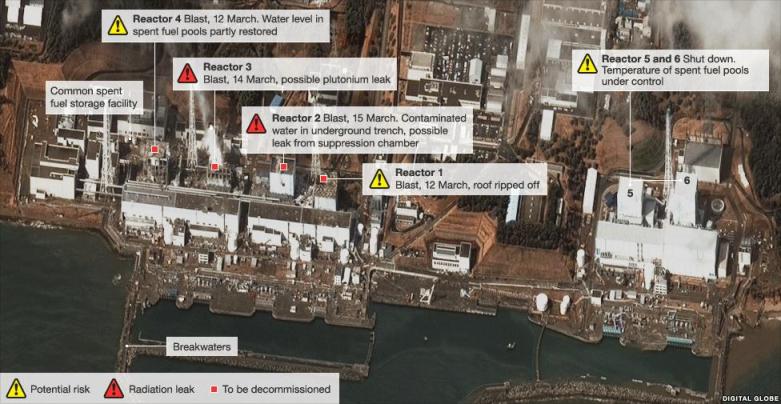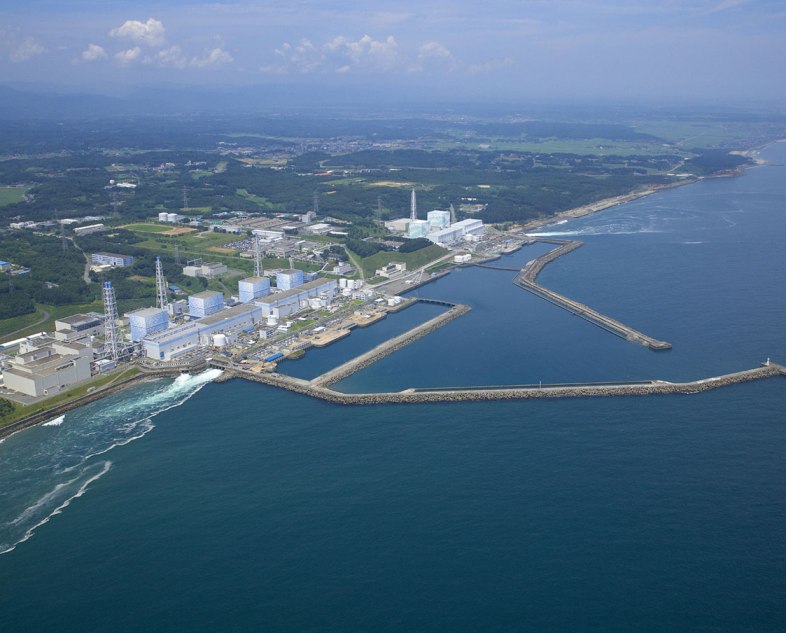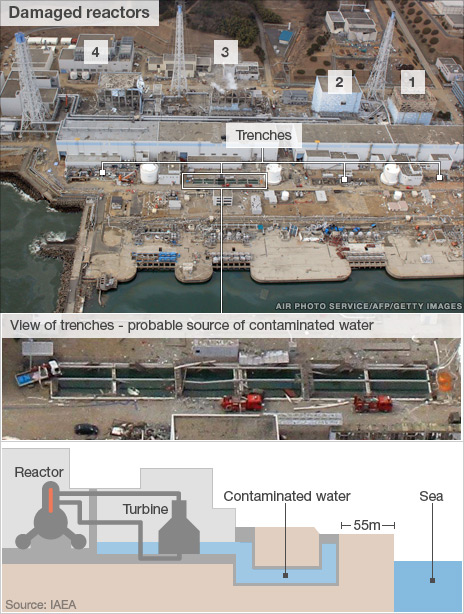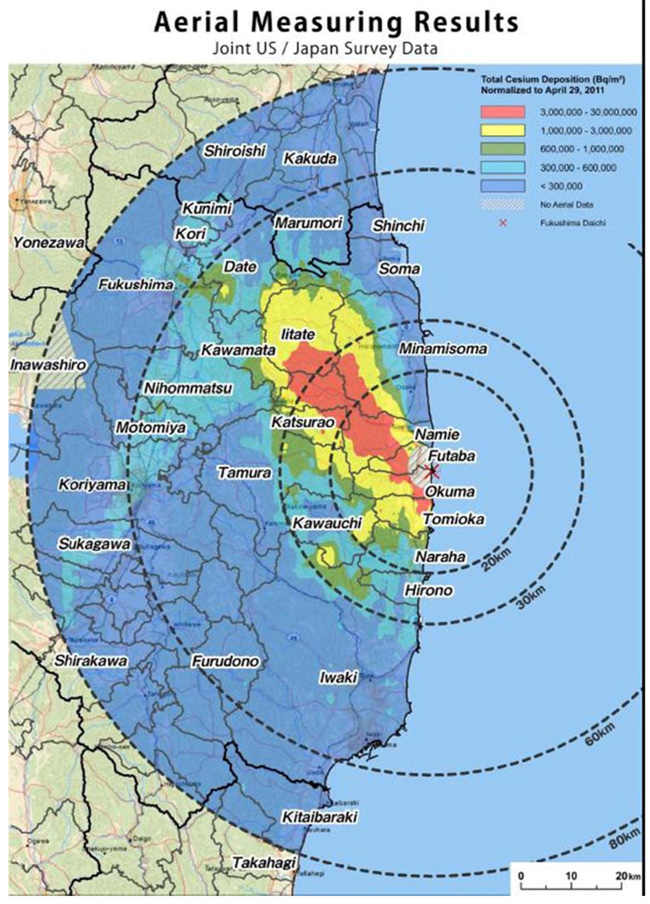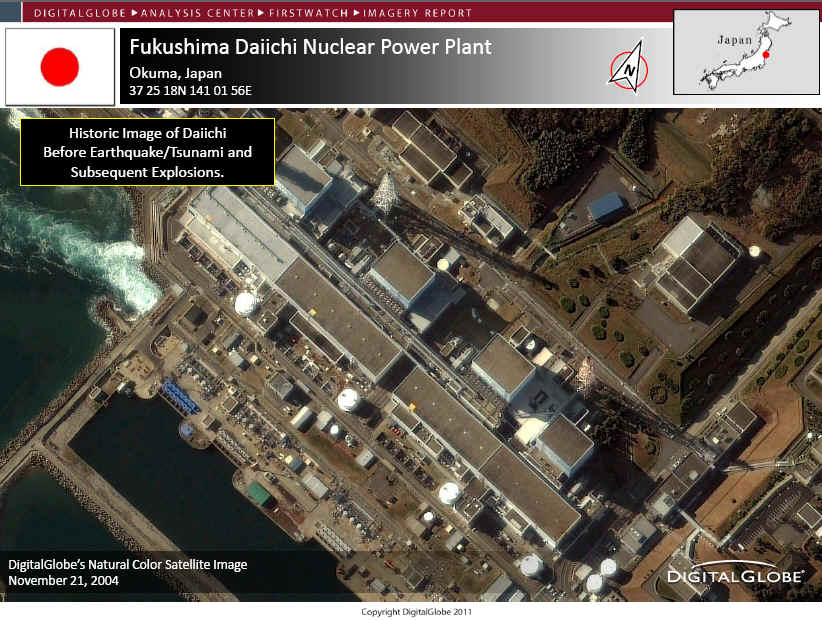
|
||||||||||||
|
|
|
Japan Nuclear Crisis
There are currently 55 operating nuclear power plants in Japan. The ten FEPC member companies own and operate 52 Light Water Reactors (LWR). Three more LWRs are operated by the private company Japan Atomic Power Corporation (JAPC). The Monju Fast Breeder Reactor (a prototype reactor which was taken off line in the 90's but expected to start up again soon) is run by the semi-governmental organization Japan Nuclear Cycle Development Institute (JNC). There are also two more nuclear plants currently under construction, as well as another 11 that are in advanced planning stages. One of those reactors in the planning stage will be owned and operated by another semi-private corporation, The Electric Power Development Co, Inc. (EPDC). Two reactors in Japan, JAPC's Tokai and JNC's Fugen Advanced Thermal Reactor prototype have been permanently closed.
TOKYO, March 25 - Japanese officials Friday announced a "voluntary" evacuation of people living within 19 miles of the damaged Fukushima Daiichi nuclear plant. A mandatory evacuation was already in place for those within 12 miles while officials suggested those within 19 miles remain inside. The government will now help everyone in the 12-to-19-mile zone leave
Fukushima Daiichi Units 1, 2 and 3 are believed to have experienced a partial meltdown, and Unit 4 has seen its spent fuel rods directly exposed to the air. The radioactive substance plutonium has been found seeping into the soil near Japan's stricken nuclear power plant, officials announced on March 29 and officials said that radiation readings at one of the plant's nuclear reactors indicate a partial meltdown and possible seawater contamination. Radioactive iodine in seawater near the stricken Fukushima Dai-ichi nuclear plant in northeastern Japan has reached 4,385 the legal limit. The International Atomic Energy Agency has also found potentially unsafe levels of radiation outside of the 12-mile evacuation radius put in place by the Japanese government, raising questions about whether the current evacuation zone is sufficient. Officials with Tokyo Electric Power Company that operates Japan's tsunami-stricken nuclear plant say radioactive contamination in groundwater underneath a reactor has been measured at 10,000 times the government health standard. A spokesman for plant operator . says the company doesn't believe any drinking water supply is affected. Contaminated water has been pooling at the Fukushima Dai-ichi nuclear power complex since it was damaged by the devastating earthquake and tsunami. It has already leaked into the ocean. Spokesman Naoyuki Matsumo says the elevated levels of iodine-131 were measured in groundwater 15 meters underneath one of six reactors at the plant. Iodine is a radioactive substance that decays quickly, with half disappearing in eight days.
On Friday, 20 May 2011, the IAEA provided the following information on the status of nuclear safety in Japan: 1. Fukushima Daiichi Nuclear Power Plant Status Tables 1 - 4 track progress made for each of Units 1 - 4 towards fulfilling the three basic safety functions of the IAEA safety standards: prevention of criticality, removal of decay heat and mitigation of radioactive releases. The tables replace the three-colour table that was used previously. The charts are cross-referenced to the Tokyo Electric Power Company (TEPCO) "Roadmap" plan to bring the nuclear reactors and the spent fuel pools at the Fukushima Daiichi plant to a stable cooling condition and to mitigate radioactive releases. On 17 May 2011, TEPCO provided a status report against the TEPCO "Roadmap". Progress has been made during the last month since the issuing of the Roadmap on 17 April 2011. While the basic policy and targets defined in the Roadmap remain, several changes were made to account for new information obtained and progress made to date. On 13 May TEPCO commenced the preparatory work for the installation of a cover for the reactor building of Unit 1. The reactor building cover will be installed as an emergency measure to prevent the dispersion of radioactive substances until mid- to long term measures, including radiation shielding, are implemented. TEPCO has reported that information obtained after calibration of the reactor water level gauges of Unit 1 shows that the actual water level in the Unit 1 reactor pressure vessel was lower than was indicated, showing that the fuel was completely uncovered. The results of provisional analysis show that fuel pellets melted and fell to the bottom of reactor pressure vessel at a relatively early stage in the accident. TEPCO reported that "most part of the fuel is considered to be submerged in the bottom of reactor pressure vessel and some part exposed." TEPCO also reported that leakage of cooling water from the reactor pressure vessel is likely to have occurred. However, TEPCO considers that the actual damage to the reactor pressure vessel is limited, on the basis of the temperatures now being measured around the reactor pressure vessel. With regard to the status of the reactor core of Unit 1, TEPCO believes that because the fuel has been being cooled continuously by means of water injection, it is unlikely that the situation could result in a future release of large amounts of radioactive material. The results of the analysis are provisional; TEPCO will continue to conduct investigations. Similar analyses will be conducted for Units 2 and 3. Nitrogen gas is still being injected into the containment vessel in Unit 1 to reduce the possibility of hydrogen combustion inside the containment vessel. In Units 1, 2 and 3 fresh water is being continuously injected into the reactor pressure vessel; temperatures and pressures remain stable. To protect against potential damage as a result of future earthquakes, TEPCO started work on 9 May to install a supporting structure for the floor of the spent fuel pool of Unit 4. Fresh water is being injected as necessary into the spent fuel pools of Units 1 - 4. Stagnant water with high levels of radioactivity in the basement of the turbine buildings of Units 1, 2 and 3 is being transferred to the condensers, the radioactive waste treatment facility, the high-temperature incinerator building and temporary storage tanks. Stagnant water in the basement of the turbine building of Unit 6 is being transferred to a temporary tank. Countermeasures against the outflow of water to the sea and to prevent and minimize the dispersion of radionuclides in water have been put in place. Full-scale spraying of anti-scattering agent is continuing at the site with the use of both conventional and remote controlled equipment. 2. Radiation Monitoring Deposition in 47 Prefectures The daily monitoring of the deposition of caesium and iodine radionuclides for 47 prefectures is continuing. Since 12 May negligible deposition has occurred. I-131 was reported in only one prefecture and Cs-137 was reported in three prefectures, with a value of 4.8 Bq/m2 for I-131 and a range of from 4.7 to 10 Bq/m2 for Cs-137. Gamma Dose Rates in 47 Prefectures Gamma dose rates are measured daily in all 47 prefectures. The Ministry of Education, Culture, Sports, Science and Technology (MEXT) of Japan reports values on the basis of data collected from each prefecture. On 18 May the value of gamma dose rate reported for Fukushima prefecture was 1.6 µSv/h. In all other prefectures, reported gamma dose rates were below 0.1 µSv/h, with a general decreasing trend. Gamma Dose Rates in Areas More Than 30 km from Fukushima Daiichi Plant Gamma dose rates reported specifically for the monitoring points in the eastern part of Fukushima prefecture, for distances of more than 30 km from the Fukushima Daiichi plant, showed a general decreasing trend, ranging from 0.1 µSv/h to 17 µSv/h, as reported for 17 May. Maps of gamma dose rates, deposition of Cs-134 and deposition of Cs-137 within the 80 km zone around the Fukushima Daiichi plant were produced by means of aerial gamma ray monitoring by the Nuclear Safety Technology Centre of MEXT and the United States Department of Energy. The map of the deposition of radiocaesium is presented in Fig. 1.The values represent the sum of Cs-134 and Cs-137. The areas in green show a deposition of these two radionuclides of between 0.6 and 1 MBq/m2. The areas in yellow indicate a deposition of between 1 and 3 MBq/m2. The areas in red indicate a deposition of between 3 and 30 MBq/m2. All are normalized to 29 April 2011. The map shows that the results obtained are consistent with all previous reported measurements of deposition in soil and of gamma dose rates. Air Concentrations of Radionuclides On-site at Fukushima Daiichi Plant On-site measurements at the west gate of the Fukushima Daiichi plant indicate the presence of I-131 and Cs-137 in the air in the close vicinity of the plant (within approximately 1 km). The values observed in the previous days show daily fluctuations with an overall decreasing tendency. Concentrations of Radionuclides in Drinking Water As of 10 May, the restriction on the consumption of drinking water relating to I-131 - which had been applied since 1 April as a precautionary measure for one remaining location (the village of Iitate in Fukushima prefecture), and only for infants - was lifted. Food Monitoring and Food Restrictions (12 - 18 May 2011) Food Monitoring From 12 to 18 May, the Ministry of Health, Labour and Welfare eported results of continued monitoring for radioactivity in food. Over this period, results for 503 food samples from fifteen different prefectures were reported. Most of this monitoring continues to be concentrated within Fukushima prefecture (39% of samples reported for 12 - 18 May). The majority of results were below regulation values, but 28 out of these 503 samples (fewer than 6%) were found to have radioactivity levels above the Japanese regulation values for radiocaesium. These samples were collected in three prefectures (Fukushima, Ibaraki and Kanagawa). None of the 503 samples was found to have radioiodine in excess of the regulation values. In Fukushima prefecture, 175 of the 194 samples (more than 90%) had radiocaesium levels below the regulation values set by the Japanese authorities. However, 19 of the 194 samples (fewer than 10%) exceeded the regulation values for Cs-134/Cs-137. Samples above the regulation values were bamboo shoots (ten samples), shiitake mushrooms (five samples), and four samples of fish (two samples of whitebait, one sample of ayu and one sample of Japanese smelt). In Kanagawa prefecture, 6 out of 33 samples (18%) were found to exceed the regulation values set by the Japanese authorities for Cs-134/Cs-137, these were six samples of unprocessed tea leaves (an additional ten samples of unprocessed tea leaves were found to have levels below this regulation value). In Ibaraki prefecture, 3 of the 66 samples (4%) reported were above the regulation values set by the Japanese authorities for Cs-134/Cs-137. These were unprocessed tea leaves (two samples) and parsley (one sample). Food Restrictions As of 18 May, the only food restrictions remaining are in Fukushima prefecture and for the cities of Kitaibaraki and Takahagi in Ibaraki prefecture. In Fukushima prefecture there are restrictions on the distribution and consumption of sand lance fish. In specified areas of Fukushima prefecture there are also restrictions on the distribution of raw unprocessed milk, turnips, bamboo shoots, ostrich ferns and shiitake mushrooms, and restrictions on the distribution and consumption of specific non-head type and head-type vegetables (e.g. spinach and cabbage), flowerhead brassicas (e.g. cauliflower) and shiitake mushrooms. In Ibaraki prefecture there is a continuing restriction on the distribution of spinach produced in the cities of Kitaibaraki and Takahagi. 3. Marine Monitoring The marine monitoring programme is carried out both near the discharge areas of the Fukushima Daiichi plant by TEPCO and at off-shore stations by MEXT. The increase in the radioactivity in the marine environment had occurred by aerial deposition and by continuing discharges and outflow of water with high levels of radioactivity from the Daiichi plant. Seawater Monitoring The activity concentrations of I-131, Cs-134 and Cs-137 in seawater close to the Fukushima Daiichi plant at the screen of Unit 2 have been measured every day since 2 April. Concentrations of Cs-134 and Cs-137 decreased from initial values of more than 100 MBq/L to less than 5 kBq/L on 7 May, but increased to levels of around 20 kBq/L on 16 May, and to about 10 kBq/L on 17 May. There was a significant increase in levels of I-131 from about 8 to 80 kBq/L from 10 to 11 May, in parallel with the increase for both radiocaesium isotopes. This indicates that there is still some production of fission products. The I-131 levels decreased to about 20 kBq/L on 17 May. Monitoring of the marine environment is performed by TEPCO in the near field area and by MEXT at off-shore sampling positions. The monitoring of MEXT also includes: measurement of ambient dose rates in air above the sea; analysis of ambient dust above the sea; analysis of surface samples of sea water; and analysis of samples of sea water collected at 10 m above the sea bottom and in a mid-layer, as well as at several locations for sediments. At most of the offshore stations, I-131, Cs-134 and Cs-137 reached levels below the detection limit of 10 Bq/L. |
|
Fukushima Daiichi 1 Ohkuma, Fukushima, Japan Boiling Water Reactor (BWR) Net Output: 439 MWe Operable. Initial criticality: 10/1970. Commercial start: 03/1971. Utility:Tokyo Electric Power Co. Reactor Supplier:General Electric Co. Steam Generator Supplier:General Electric Architecture:Ebasco Construction:Kajima |
Fukushima Daiichi 2 Ohkuma, Fukushima, Japan Boiling Water Reactor (BWR) Net Output: 760 MWe Operable. Initial criticality: 05/1973. Commercial start: 07/1974. Utility:Tokyo Electric Power Co. Reactor Supplier:General Electric Co. Steam Generator Supplier:General Electric Architecture:Ebasco Construction:Kajima |
Fukushima Daiichi 3 Ohkuma, Fukushima, Japan Boiling Water Reactor (BWR) Net Output: 760 MWe Operable. Initial criticality: 09/1974. Commercial start: 03/1976. Utility:Tokyo Electric Power Co. Reactor Supplier:Toshiba Steam Generator Supplier:Toshiba Architecture:Toshiba Construction:Kajima |
|
Fukushima Daiichi 4 Ohkuma, Fukushima, Japan Boiling Water Reactor (BWR) Net Output: 760 MWe Operable. Initial criticality: 01/1978. Commercial start: 10/1978. Utility:Tokyo Electric Power Reactor Supplier:Hitachi Steam Generator Supplier:Hitachi Architecture:Hitachi Construction:Kajima |
Fukushima Daiichi 5 Ohkuma, Fukushima, Japan Boiling Water Reactor (BWR) Net Output: 760 MWe Operable. Initial criticality: 08/1977. Commercial start: 04/1978. Utility:Tokyo Electric Power Reactor Supplier:oshiba Steam Generator Supplier:Toshiba Architecture:Toshiba Construction:Kajima |
Fukushima Daiichi 6 Ohkuma, Fukushima, Japan Boiling Water Reactor (BWR) Net Output: 1067 MWe Operable. Initial criticality: 03/1979. Commercial start: 10/1979. Utility:Tokyo Electric Power Reactor Supplier:General Electric Steam Generator Supplier:General Electric Architecture:Ebasco Construction:Kajima |
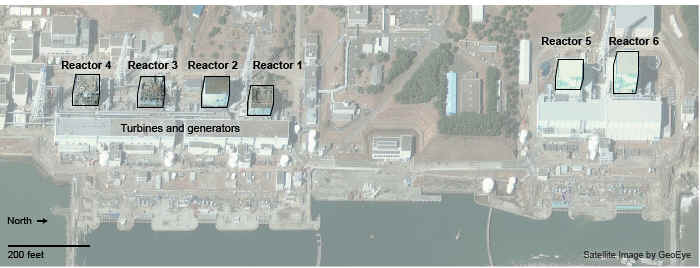
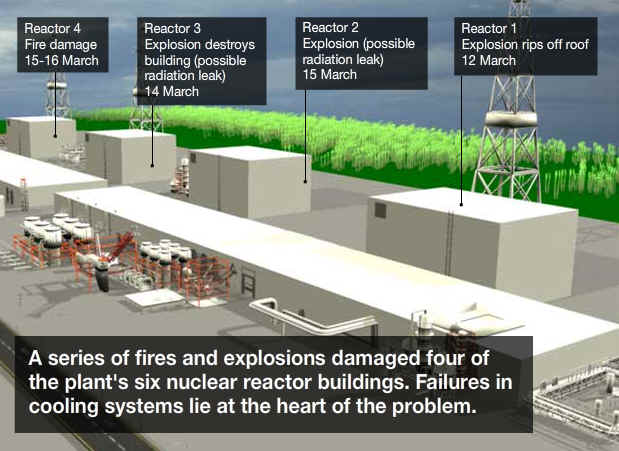


The damaged roof of reactor number No. 1 at the Fukushima Daiichi nuclear plant after an explosion that blew off the upper part of the structure is seen in this handout photo released by Tokyo Electric Power Company (TEPCO) in Fukushima Prefecture, northeastern Japan, March 12, 2011
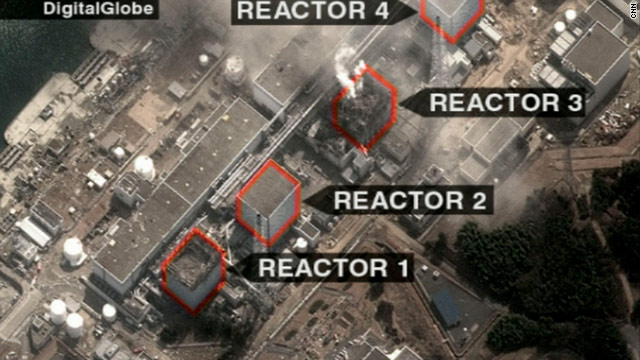
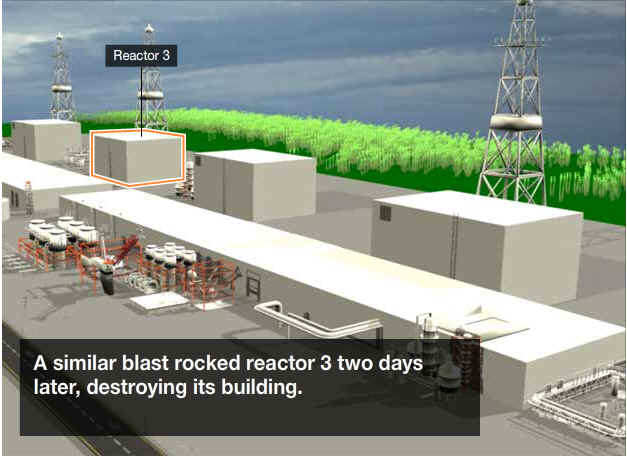
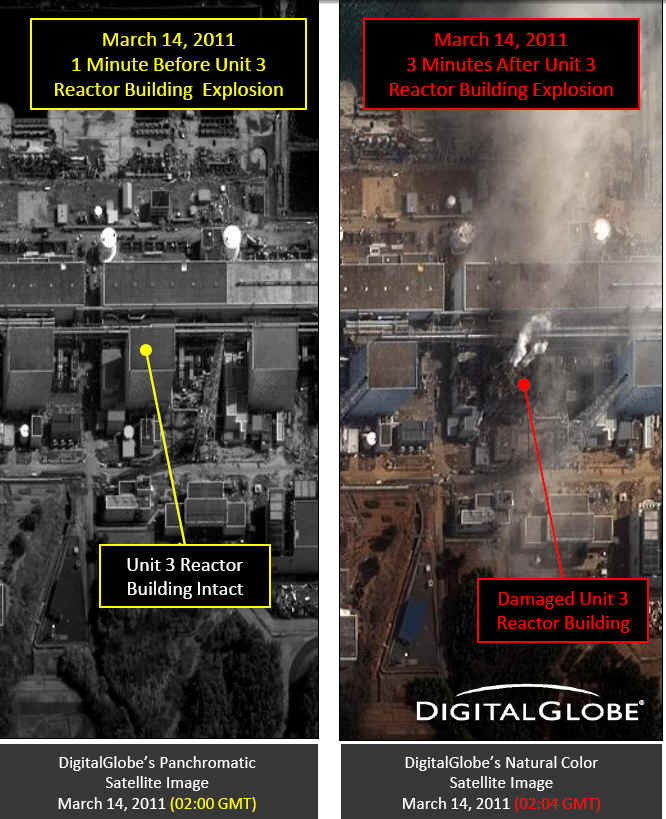
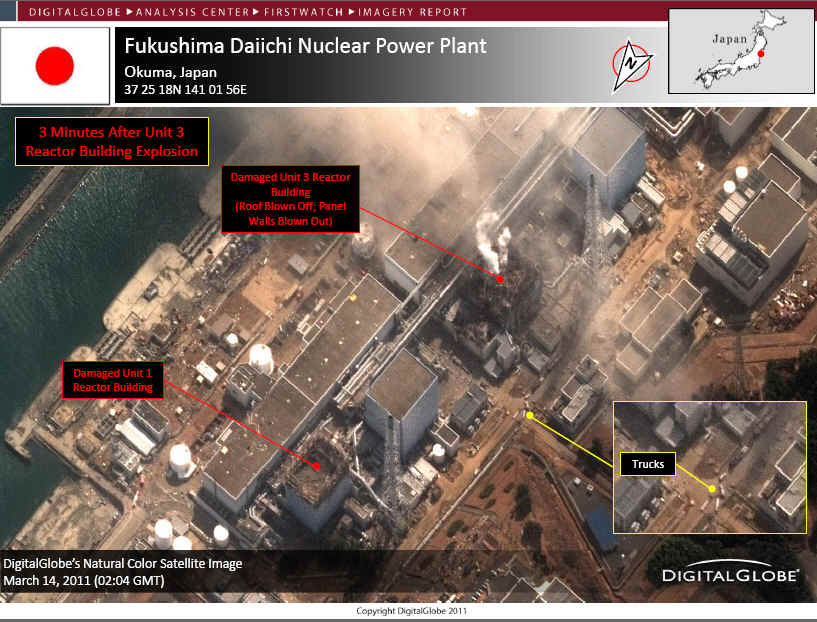
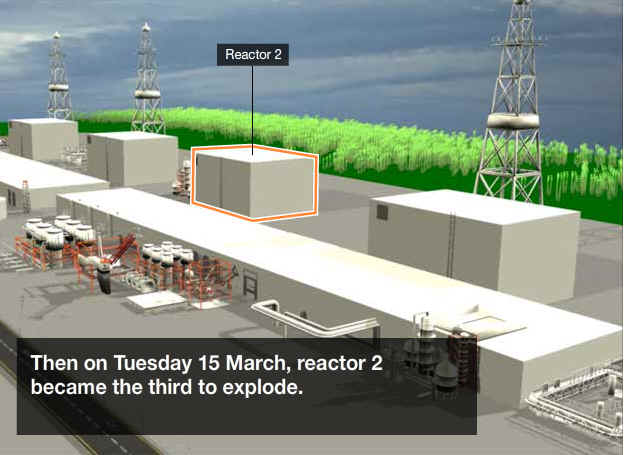
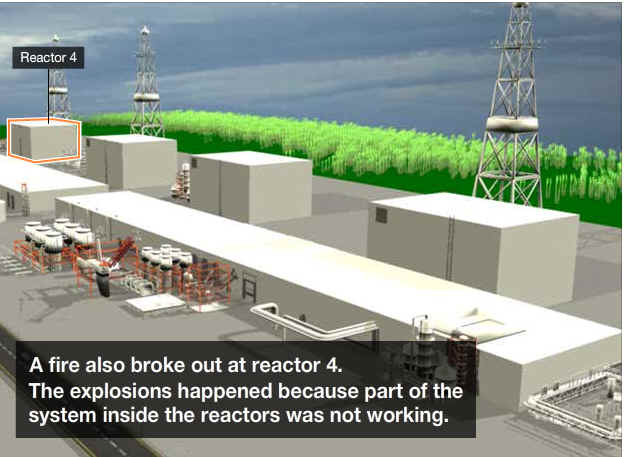
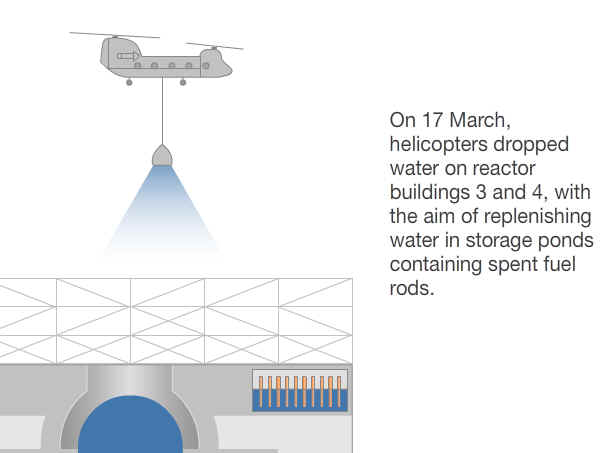
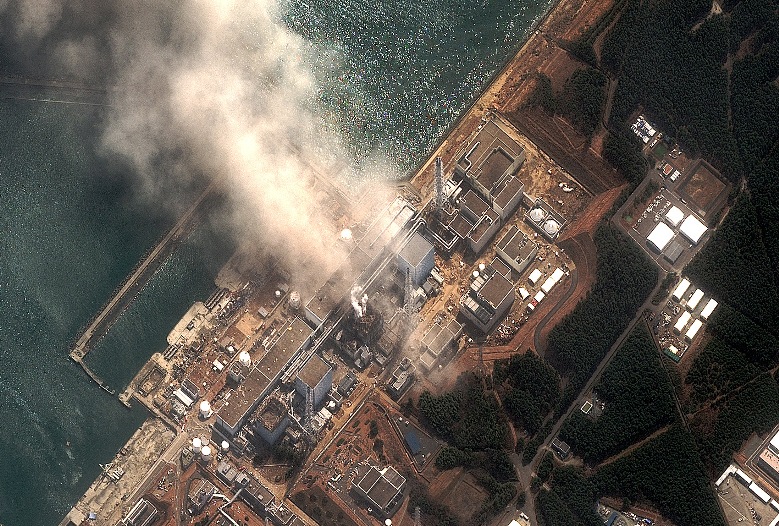
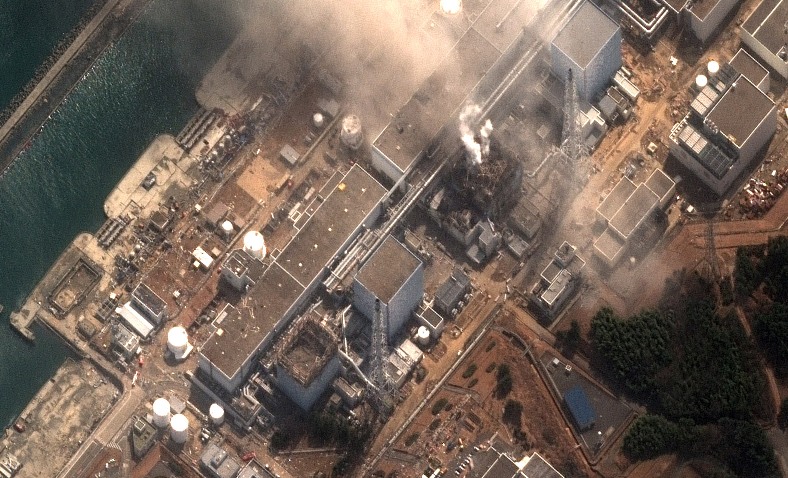
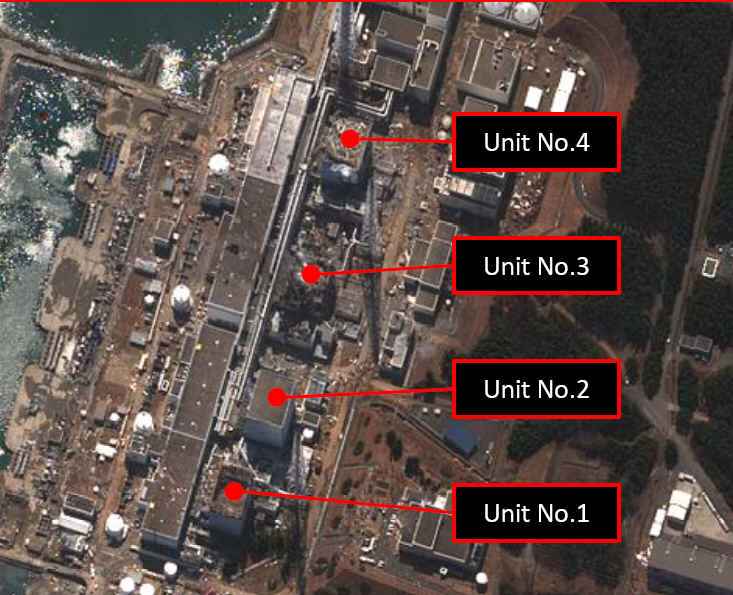
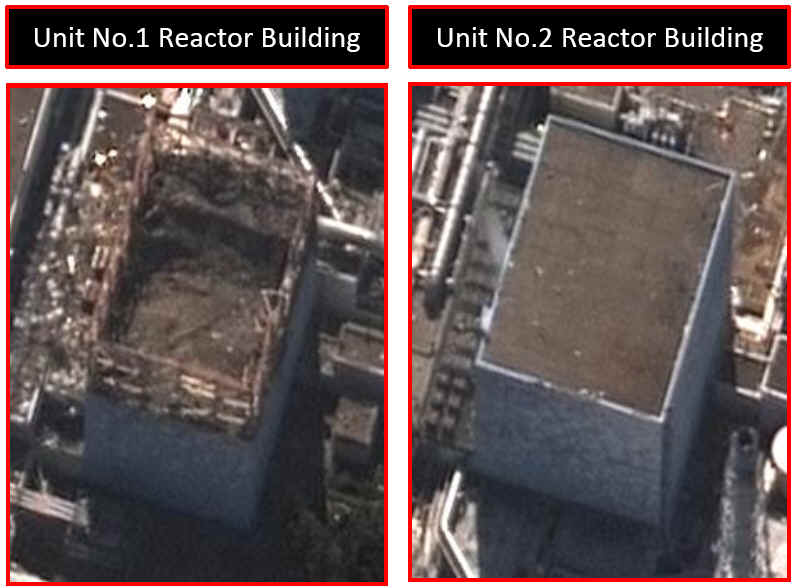
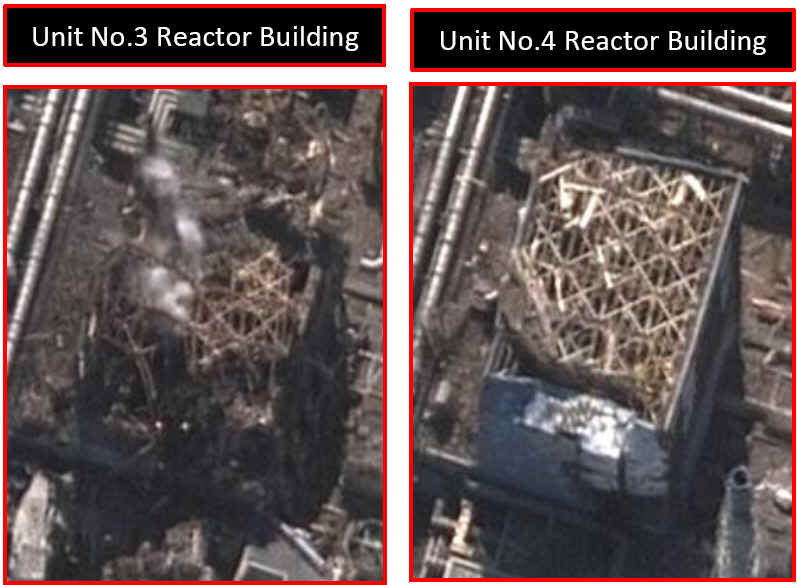
The ongoing crisis at Japan's Fukushima nuclear power plant has been upgraded to a level 7 on the International Nuclear Events Scale. To put this into perspective, the Chernobyl diaster was a level 7, and the Three mile Island accident was a level 5.
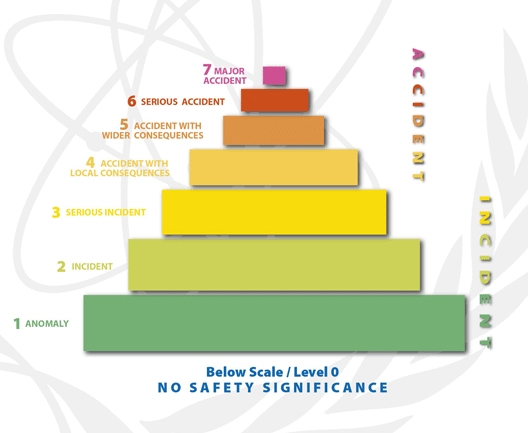
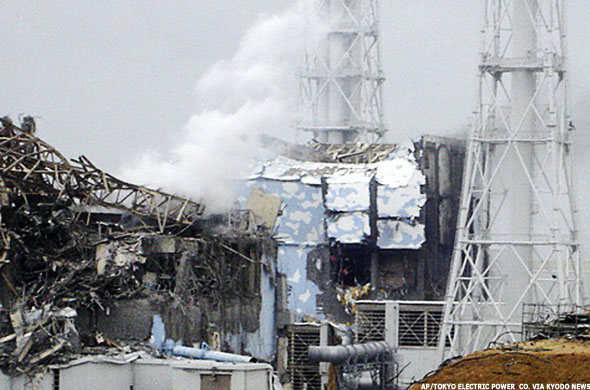
White smoke billows from the No. 3 unit next to the damaged No. 4 unit at the Fukushima Dai-ichi nuclear complex in Japan.
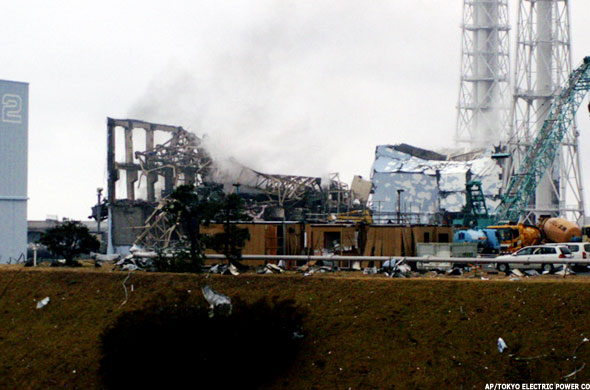
Smoke rises from Unit 3 at the damaged Fukushima Dai-ichi power plant in Japan
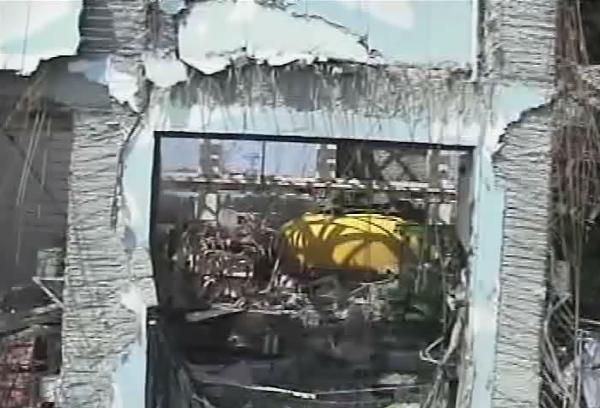
In this image taken by T-Hawk drone aircraft, Tokyo Electric Power (TEPCO) Co.'s crippled Fukushima Daiichi Nuclear Power Plant No.4 reactor's operating floor which has been exposed due to a destruction of its exterior after being damaged by the tsunami is seen in Fukushima, northern Japan April 15, 2011, in this handout photo released by TEPCO April 16, 2011. Japan has told the U.N. atomic agency that 28 nuclear workers have received high radiation doses as they battle to stabilise the stricken Fukushima Daiichi power plant. Picture taken April 15, 2011.
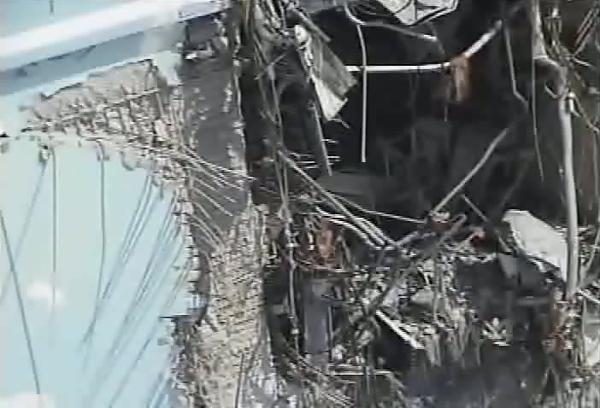
In this image taken by T-Hawk drone aircraft, Tokyo Electric Power (TEPCO) Co.'s crippled Fukushima Daiichi Nuclear Power Plant No.4 reactor building is seen in Fukushima, northern Japan April 15, 2011, in this handout photo released by TEPCO April 16, 2011. Japan has told the U.N. atomic agency that 28 nuclear workers have received high radiation doses as they battle to stabilise the stricken Fukushima Daiichi power plant. Picture taken April 15, 2011
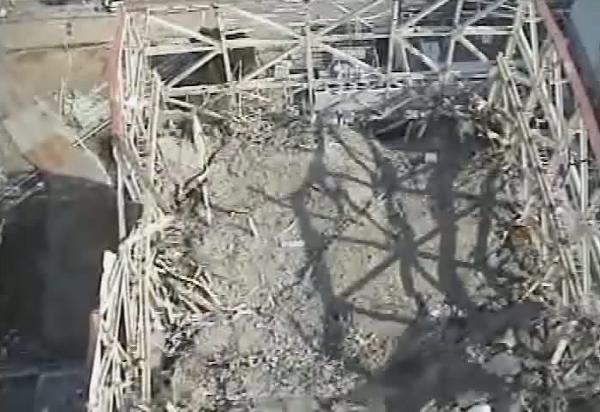
In this image taken by T-Hawk drone aircraft, Tokyo Electric Power (TEPCO) Co.'s crippled Fukushima Daiichi Nuclear Power Plant No.1 reactor building's rooftop is seen in Fukushima, northern Japan April 15, 2011, in this handout photo released by TEPCO April 16, 2011. Japan has told the U.N. atomic agency that 28 nuclear workers have received high radiation doses as they battle to stabilise the stricken Fukushima Daiichi power plant. Picture taken April 15, 2011.
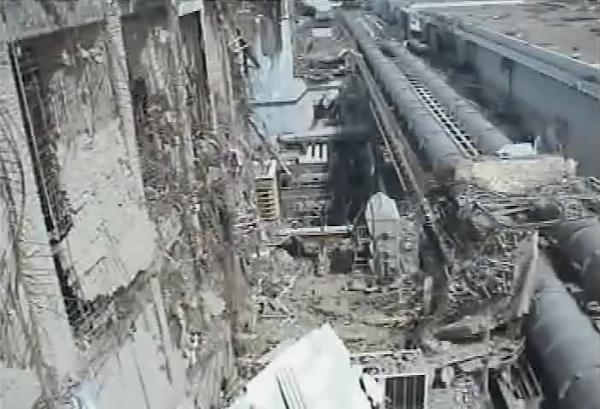
In this image taken by T-Hawk drone aircraft, Tokyo Electric Power (TEPCO) Co.'s crippled Fukushima Daiichi Nuclear Power Plant No.4 reactor building in Fukushima, northern Japan April 15, 2011 is seen in this handout photo released by TEPCO April 16, 2011. Japan has told the U.N. atomic agency that 28 nuclear workers have received high radiation doses as they battle to stabilise the stricken Fukushima Daiichi power plant. Picture taken April 15, 2011.
Fukushima Daini
| Press
Release (May 28,2011) Plant Status of Fukushima Daini Nuclear Power Station (as of 3:00 pm, May 28) |
On March 11 2011, turbines and reactors of Fukushima Daini Nuclear Power Station Units 1 to 4 (Boiling Water Reactors, rated output 1,100 Megawatts) that we had been constantly operating at rated thermal output were automatically shut down at 2:48 pm due to the Tohoku-Chihou-Taiheiyou-Oki Earthquake (previously announced on March 11). At 7:15 pm on March 15, the reactor of Unit 4 achieved cold shutdown. As a result, all reactors of Units 1 to 4 at Fukushima Daini Nuclear Power Station achieved cold shutdown (previously announced on March 15). As of 3:00 pm on May 26, the reactors of Unit 1 to 4 are in cold shutdown (please refer to the appendix). We continue to make our endeavors to stabilize each plant. |
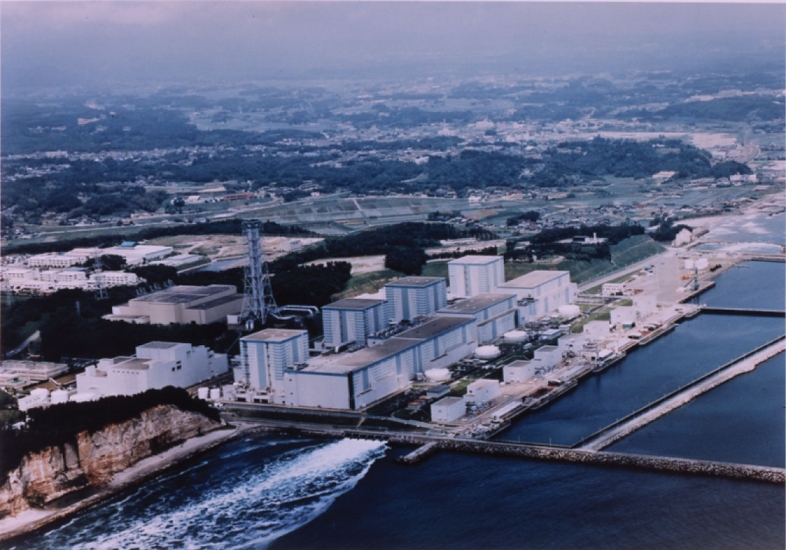
| Power plant name (Unit number) |
Location | Reactor type |
Licensed output (MWe) |
Start of commercial operation |
|---|---|---|---|---|
| Fukushima Daini(Unit.1) | Fukushima prefecture | BWR | 1100 | Apr.20.1982 |
| Fukushima Daini(Unit.2) | Fukushima prefecture | BWR | 1100 | Feb. 3.1984 |
| Fukushima Daini(Unit.3) | Fukushima prefecture | BWR | 1100 | Jun.21.1985 |
| Fukushima Daini(Unit.4) | Fukushima prefecture | BWR | 1100 | Aug.25.1987 |
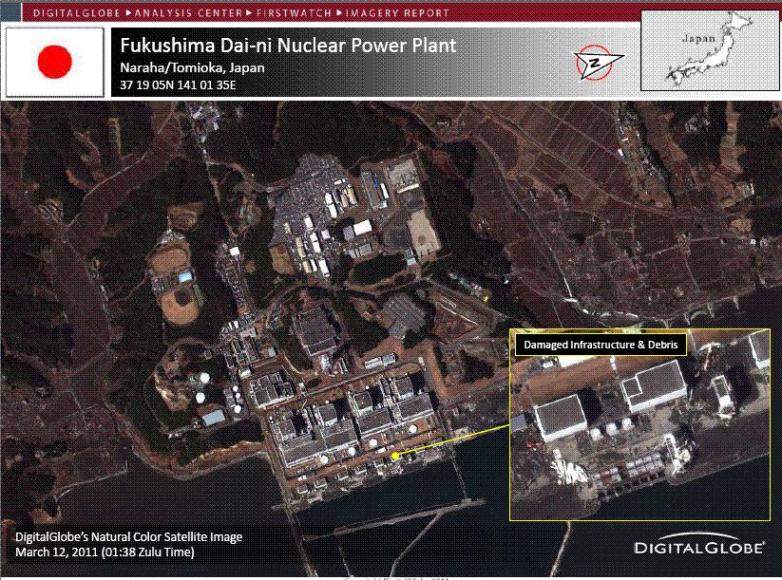
Timeline
(Times are Japan time, which is GMT +9, unless stated)
Friday, 11 March: 1446 local time (0546 GMT)
The 8.9-magnitude earthquake strikes off the coast of Honshu island at a depth of about 24km. The tremor triggers the automatic shutdown of 11 of the nation's nuclear power reactors, including reactor units 1,2 and 3 at the Fukushima Daiichi power plant. Reactor units 4, 5 and 6 were undergoing routine inspections, so were not operating.
The quake causes the power station to be cut off from the national electricity grid. The plant's operators, Tokyo Electric Power Co (Tepco), find that the diesel-powered emergency generators for units 1 and 2 are not working and notify government officials.
1541: Tepco reports that the emergency generators for reactor units 1, 2 and 3 have failed - some reports suggest that the diesel-powered back-up systems are affected by the tsunami.
In the following hours, engineers attempt to install mobile power units to replace the diesel systems and manage to stabilise conditions at units 2 and 3, but not at unit 1.
1600: Japan's Nuclear and Industrial Safety Agency (Nisa) sets up an emergency headquarters to gather information on potential damage to the nation's 55 nuclear reactors.
1930: Chief Cabinet Secretary Yukio Edano announces that Prime Minister Naoto Kan has declared a "nuclear emergency status". Officials reassure people that this is standard procedure in events like this and no radioactive material has been detected in the area surrounding the power station.
2100: Residents within a 3km radius of the power station are told to leave their homes, while those within a 10km radius are told to stay at home in case it is necessary to extend the evacuation area.
Following the automatic shutdown of the reactors, and the failure of emergency generators, pressure in the unit builds up as a result of the pumps in the cooling system not working properly.
The pressure is the result of the reactor's residual "decay" heat causing the coolant, which is not being circulated, to evaporate.
The consequent increase in pressure in the coolant circuit can be controlled by pressure release valves, but this leads to an increase in pressure within the reactor building containment chamber.
Tepco says that the pressure inside reactor unit 1 is more than twice normal levels.
Saturday, 12 March: 0530 local time
In order to release some of the pressure inside the reactor unit, the decision is taken to vent some of the steam, which contains a small amount of radioactive material, into the air.
0819: An alarm alerts workers that the position of one control rod (used to halt the reactor) is unclear (whether it is fully inserted into the reactor or outside the reactor, allowing it to continue generating heat)
1009: Tepco confirms it has released a small amount of vapour into the atmosphere to reduce pressure in reactor unit 1.
1043: Control rod alarm stops, and all rods are confirmed as being fully inserted.
1058: In order to release some of pressure inside reactor unit 2, some steam was vented into the air. Again, this contains a small amount of radioactive material.
1530: TV cameras capture a massive explosion at the power station. The pictures appear to show that the outer structure of one of four buildings at the plant has collapsed. Tokyo Electric Power Co says four workers have been injured in the blast.
2000: Uncertainty surrounds what was the actual cause of the explosion, and what damaged was caused by the blast.
Chief Cabinet Secretary Yukio Edano confirms that the concrete building surrounding the steel reactor container has collapsed as a result of the blast, but the steel containment chamber itself had not been damaged.
2020: Tepco begins pumping seawater, mixed with the element boron, into unit 1's reactor. Boron is used as a shield in nuclear reactors, as it controls the nuclear reaction.
Nisa confirms that monitoring systems in the area have detected presence of radioactive elements caesium-137 and iodine-131 in the vicinity of unit 1. It reports an initial increase in levels of radioactivity around the plant, but says these levels have been observed to lessen.
2300: In its latest update, the plant's operator says: "We are preparing to implement a measure to reduce the pressure of [unit 3's] reactor containment vessels under the instruction of the national government."
Sunday, 13 March: 0122 local time
An official at Japan's nuclear agency rates the incident at 4 on the 0-7 international scale of severity. The 1986 Chernobyl disaster was rated 7, while the 1979 Three Mile Island accident was rated 5.
0320: The World Health Organisation says the risk to the public from the radiation leak at Fukushima is "probably quite low".
0523: The International Atomic Energy Agency says the plant's operator has confirmed that the containment vessel around unit 1 is intact and levels of radioactivity nearby have fallen in recent hours.
0623: An official from Nisa says the emergency cooling system at the plant's unit 3 reactor has failed.
0752: Tepco say it is preparing to release steam - containing a small amount of radioactive material - from unit 3 in an effort to lower the temperature inside. It is also looking for an alternative way to inject water into the reactor because without a continuous flow of water, there is a danger that the fuel rods will become exposed to the air and could melt.
0826: Yukio Edano tells state TV the unit 3 reactor was in danger, but attempts are under way to vent steam. Subsequently, it is reported that radiation has again risen above legal safety limits around the plant.
1326: Mr Edano says venting of unit 3 was completed at 0841 local time, but a partial meltdown in the reactor is still "highly possible".
1538: The Japanese government warns of the risk of another reactor explosion following the failure in unit 3. But a spokesman attempts to reassure people by saying the unit is designed to protect the reactor core in the same way as unit 1, and - so far - the radioactivity released into the environment does not pose a threat to human health.
2005: In his latest public briefing on the situation, Mr Edano says authorities have begun injecting seawater into the unit 3 reactor to try to lower the temperature - as they did on Saturday with unit 1.
He says the water level inside is thought to be rising to more satisfactory levels, but the gauge, which seems to be broken, is not showing this.
2209: It is reported that Tepco is planning to pump seawater into reactor number 2 at the plant - this is the first time problems have been reported with this third unit.
It is worth noting that using seawater like this is terminal for a nuclear reactor. It is a last-ditch move and renders the reactor permanently unusable.
2241: UN nuclear watchdog, the IAEA, says a state of emergency has been declared at a second Japanese nuclear power plant, Onagawa. The IAEA says high radiation levels had been found around the plant. A fire broke out in the turbine building of one the reactors at Onagawa on Friday, but was put out.
2350: Japan's nuclear safety agency says there is no problem with the cooling systems at the Onagawa plant. It blames the high radiation levels on radioactive releases from the Fukushima Daiichi complex.
Monday, 14 March: 0053 local time
01:43 - Japan Atomic Power says the cooling process was working at its Tokai No.2 nuclear power plant's reactor although two of the three diesel power generators used for cooling were out of order. The reactor at the plant, about 120 km (75 miles) north of Tokyo in Ibaraki prefecture, was automatically shut after Friday's massive earthquake and tsunami.
07:29 - TEPCO says it has reported a rise in radiation levels at its Fukushima Daiichi nuclear power plant to the government.
11:11 - Domestic media image shows smoke rising from the No.3 reactor at Japan's Fukushima Daiichi nuclear plant. Japanese TV says there was a hydrogen explosion at the plant.
11:20 - Japan's nuclear safety agency confirms a new explosion rocked Japan's stricken Fukushima Daiichi nuclear power complex, sending a plume of smoke into the air. But it says it cannot confirm whether or not the hydrogen explosion at the plant's No.3 reactor has led to an uncontrolled leak of radioactivity.
11:40 - Jiji quotes TEPCO as saying a fresh explosion that rocked the Fukushima Daiichi nuclear power complex has not damaged the plant's No.3 reactor vessel.
12:43 - Chief Cabinet Secretary Yukio Edano says a large-scale radiation leakage is unlikely from the Fukushima Daiichi nuclear power plant's No. 3 reactor hit by an explosion after cooling problems.
15:17 – Jiji news agency reports that there has been an explosion at a fuel oil tank at a thermal power plant in Fukushima and that the tank is on fire. It is not immediately clear which company the thermal power plant belonged to.
15:26 – The IAEA says Japan has told the U.N. nuclear watchdog the
hydrogen explosion at the No.3 reactor at Fukushima Daiichi did not damage
the primary containment vessel.
16:17 – Chief Cabinet Secretary Yukio Edano confirms water levels at the
Fukushima Daiichi plant No.2 reactor are falling and its cooling functions
have stopped.
17:23 – Jiji news agency says Japanese authorities have safely cooled down
two nuclear reactors at the Fukushima Daini nuclear plant, close to
another nuclear complex where they are still struggling to cool three
overheating reactors.
19:52 – Jiji quotes TEPCO as saying nuclear fuel rods at the Fukushima
Daiichi complex’s No.2 reactor, where levels of water coolant around the
reactor core had been reported as falling earlier in the day, are now
fully exposed. Jiji says a meltdown of the fuel rods cannot be ruled out.
20:10 - Water levels inside the Fukushima Daiichi complex’s No. 2 reactor
are almost empty, TEPCO says. Jiji news agency says the operator of the
plant has started injecting sea water to the reactor in the hope of
cooling it down.
TUESDAY, MARCH 15
06:45 - Some damage has been detected at Fukushima Daiichi No. 2 reactor,
but no sharp increase in radiation levels has been seen, Chief Cabinet
Secretary Yukio Edano says.
07:57 – Fresh explosion heard at the plant, Japan’s nuclear safety agency
says.
08:45 – The roof above overheating No. 2 reactor is damaged and steam in
rising from the complex, Jiji news agency reports.
09:01 – Radiation levels in the air surrounding the plant have risen
fourfold after the explosion, plant operator TEPCO says.
10:03 – The nuclear safety agency says it is unsure if the explosion at
the reactor has damaged one of its reactor containment vessels. If the
containment vessel were to break and fuel rods within it to melt, it could
cause a major radiation leak.
11:08 – Risk of a nuclear leakage is rising, Prime Minister Naoto Kan
says, and warns people within a 30-km radius to stay indoors.
11:41 – Radiation levels in Kanagawa prefecture, west of Tokyo, are up to
nine times the normal level briefly on Tuesday, Kyodo news agency says,
quoting the prefecture government.
11:57 - Japan’s science minister has asked local governments to make more
frequent radiation checks, Kyodo news agency says. The agency also says
there has been one explosion at the No. 4 reactor at a stricken plant.
12:03 – Winds over the plant are blowing in a southwesterly direction that
includes Tokyo, but will shift later on Tuesday, the weather agency says.
12:37 – Minute levels of radiation have been detected in Tokyo, Kyodo
says, quoting local government.
14:00 – Radiation levels in Tokyo are “not a problem”, the city government
says.
14:03 – Prime Minister Kan sends a text message to mobile phone users
across the country, asking them to conserve power.
14:07 – A no-fly zone is established for a 30-km radius around the plant,
Jiji news agency says, quoting the transport ministry.
14:46 – Radiation levels in the city of Maebashi, 100 km north of Tokyo,
are up to 10 times normal, Kyodo says, quoting the city government.
16:44 – Japan has told the United Nations nuclear watchdog (IAEA) that it
has extinguished a fire at the spent fuel storage pond at the power plant,
the Vienna-based agency says.
17:28 – Radiation levels fall at the plant, the government says. Chief
Cabinet Secretary Yukio Edano says the radiation level at the main gate of
the Fukushima Daiichi complex is 596.4 microsieverts per hour as of 0630
GMT, down from 11,930 microsieverts at 0000 GMT.
17:31 – Japan has told the U.N. Agency radioactivity was being released
“directly” into the atmosphere, the IAEA says.
17:48 – A pool containing spent fuel at the No.4 reactor may be boiling
and the water level may be falling, Kyodo news agency quoted an official
at the reactor’s operator as saying.
18:01 – TEPCO has pulled out 750 workers from the plant since Tuesday, and
50 remain, it says.
18:06 – Radiation levels in Chiba prefecture, near Tokyo, are more than 10
times above normal levels, Kyodo reports.
18:20 – Japan’s nuclear safety agency says there are two holes of 8-metres
square in a wall of the outer building of the quake-hit Fukushima Daiichi
No.4 reactor after a blast in the morning.
19:09 – Winds are now dispersing radioactive material from the Japanese
nuclear crisis over the Pacific Ocean, away from Japan and other Asian
countries, the World Meteorological Organisation (WMO) says.
20:50 – The radiation level in the Japanese capital, Tokyo, is 10 times
normal, but there is no threat to human health, the city government says.
20:54 - Radiation levels at the No. 4 reactor of the Fukushima Daiichi
nuclear-power plant has become too high to conduct normal work from its
control room, Kyodo news agency says. Workers cannot stay long and are
going in and out of the control room as well as monitoring from a
different place.
21:11 - TEPCO says it may pour water into the overheating fuel pool in the
No. 4 reactor of the Fukushima Daiichi nuclear-power plant within two or
three days, possibly through holes in the building into the spent fuel
pool. It adds holes in the wall of the outer building of the reactor mean
spent nuclear fuel pool is exposed to outside air.
Wednesday, March 16
11:10 - A fuel pool at the No.3 reactor at the Fukushima Daiichi plant may have heated and produced steam, TEPCO says. Media images earlier showed white smoke drifting from the plant.
11:19 - The radiation reading at the main gate of the plant rose sharply
just after 0100 GMT on Friday and started to fall almost an hour later,
the government says.
11:30 - It is not realistic to think that the No. 4 reactor at the plant
will "reach criticality", the chief government spokesman says.
11:38 - Japan may seek direct U.S. military help to end the crisis at the
plant, the chief government spokesman says.
13:27 - Japan's nuclear safety agency says operators of the damaged
nuclear plant plan to bulldoze an emergency route to the facility to allow
access for fire trucks.
16:05 - The temperature stabilised and pressure dropped at the No. 2
reactor, the plant operator said.
16:55 - Operator says as of 0230 GMT there were 180 workers on site at the
damaged nuclear power complex.
16:55 - Tokyo Electric Power Co says it recorded the site's highest levels
of radiation at the No.3 reactor on Wednesday.
17:26 - The operator of Japan's quake-stricken nuclear power complex,
Tokyo Electric Power Co Ltd , says it is unable to resume work on cooling
reactors due to radiation risk.
17:32 - The World Health Organisation's representative in China says there
is no evidence of any significant international spread of radiation from
the nuclear site.
18:00 - Japan's top government spokesman says radiation levels around the
nuclear plant are not at levels to cause an immedaite health risk.
18:14 - A helicopter was unable to drop water to cool a quake-stricken
reactor in northeastern Japan probably because of the high radiation,
Kyodo news agency says, quoting the defence minister.
18:29 - Water is being poured into reactors No.5 and No.6 at Fukushima's
Daiichi nuclear power plant, the operating company says.
19:47 - No radioactive iodine or cesium was found in the tap water of
Japan's Fukushima prefecture, Kyodo news agency reports, quoting the local
government.
19:53 - Japanese police will attempt to cool the spent nuclear fuel pool
at the No. 4 reactor at the stricken Fukushima Daiichi nuclear plant using
a water cannon truck as early as Wednesday night, NHK television says.
21:01 - Major damage is unlikely to have been sustained at the No.3
reactor of Japan's quake-stricken nuclear power plant, Kyodo reports,
quoting the government.
21:48 - Japan wants to use its military to help pump water to the No.3
reactor and into a spent-fuel pool at the No.4 reactor of a quake-stricken
nuclear plant, the nation's nuclear safety agency says.
Radiation levels at a monitoring post outside the Fukushima Daiichi plant
had spiked at 0330 GMT to 10,850 microsieverts per hour, but fell back
later to 2,331 microsieverts an hour later, it says.
THURSDAY, MARCH 17
06:06 - The Nuclear and Industrial Safety Agency says radiation levels at
the Fukushima plant had fallen over the past 24 hours. A reading of 338
microsieverts per hour was recorded at the main gate at 05:00 against 752
12 hours earlier.
07:43 - Japan's weather agency said winds near the plant are forecast to
blow from the northwest on Thursday towards the Pacific Ocean.
08:38 - A Japanese military helicopter begins spraying water on the plant,
the Defence Agency is quoted as saying. Officials later say two of four
water drops hit their mark.
09:55 - Australia issues new appeal to nationals in Tokyo and eight other
prefectures to consider leaving Japan.
10:30 - Kyodo news agency says the United States will fly a high-altitude
drone equipped with infrared sensors over the plant to help determine what
is happening inside.
11:24 - TEPCO says pressure is rising again at reactor No. 3. It says
there was still water in its spent-fuel pool. On Wednesday, the company
described the situation there as "not so good." The U.S. Nuclear Regulator
Commission said on Wednesday there was no water in the pool.
12:59 - U.S. State Department authorises voluntary departure from Japan of
family members of diplomatic staff.
16:27 - An unexpected, large-scale power outage is possible in Tokyo and
surrounding areas on Thursday evening if power demand exceeds this
morning's, Japan's trade minister says.
17:20 - Low concentrations of radioactive particles are heading eastwards
from the plant towards North America, a Swedish official says. The
official at the Swedish Defence Research Institute, a government agency,
was citing data from international monitoring stations. Levels were not
dangerous for people, he says.
17:37 - Three of the six reactors at the earthquake-hit Fukushima Daiichi
nuclear plant in northern Japan are now relatively stable, officials say.
21:07 - TEPCO said it had started
work to connect outside
power cables to the plant and that electricity could be connected on
Thursday.
21:39 - Japan's nuclear safety agency said a pool for cooling spent
nuclear fuel at the No.4 reactor of the stricken plant remains a serious
concern.
FRIDAY, MARCH 18
09:20 - White smoke or steam was rising from reactors 2, 3 and 4, the
nuclear safety agency said on Friday. It said it believed there was still
water in the spent fuel pool at reactor No.3.
10:04 - Japan's nuclear safety agency said it was aware of the ultimate
"Chernobyl solution" to contain the nuclear disaster at the quake-hit
plant by covering it in sand and encasing it in concrete, but added that
it was currently focusing on efforts to restore power and cool down the
reactors.
17:53 - Electricity could be restored on Saturday morning at the No.1 and
No.2 reactors, the country's nuclear safety agency said on Friday. The
agency also raised the incident level at reactors No.1, No.2, and No.3 at
the Daiichi plant to level 5 from level 4.
18:11 - Japan has raised the incident level at the nuclear reactor, the
U.N. nuclear watchdog reported on a monitoring website.
20:01 - Electricity could be restored on Saturday morning at the No.4
reactor at the crippled Fukushima Daiichi nuclear power plant in northeast
Japan, TEPCO said.
20:02 - Japan's Prime Minister Naoto Kan, under increasing pressure for
his handling of the aftermath of the country's devastating earthquake and
nuclear crisis, may visit worst-hit areas of the northeast next week, a
senior official said on Friday.
21:02 - Japanese engineers cannot say if damaged nuclear reactors are
under control, Hideohiko Nishiyama, deputy director general of the Nuclear
and Industrial Safety Agency, told reporters.
The entry gave the accident at the Fukushima Daiichi site a level 5
rating, up from level 4 previously on a 1-7 scale.
SATURDAY, MARCH 19
03:30 - TEPCO said it had connected an external transmission line with the stricken plant and confirmed that electricity could be supplied.
06:08 - The U.S. government says that "miniscule" amounts of radiation are
detected in Sacramento, California, but that no radiation levels of
concern have been uncovered in United States.
15:24 - The World Health Organisation says that the detection of radiation in food after an earthquake damaged a Japanese nuclear plant was a more serious problem than it had first expected.
16:13 - Japan's top government spokesman says tests detect radiation above
the national safety level in spinach and milk produced near the Fukushima
nuclear plant.
18:01 - Engineers attach a power cable to one of Japan's quake-stricken
reactors but electricity has yet to be switched on, the nuclear safety
agency said.
22:42 - A sample of tap water from Tokyo shows a tiny level of radioactive
iodine, the government said. The sample contained 1.5 becquerals per kg of
iodine 131, well below the tolerable limit for food and drink of 300
becquerals per kg, the government added.
SUNDAY, MARCH 20
00:29 - The U.N. nuclear watchdog says it is unclear whether water pumps at Japan's disaster-hit nuclear power plant will work once power is restored.
16:37 - The Japanese government will decide by Monday on whether to
restrict consumption and shipments of food products from the area in the
vicinity of a quake-hit nuclear complex, after higher-than-normal levels
of radiation were found in milk and spinach from the area.
16:53 - Japan's Kansai Electric Power plans to delay the reopening of two
nuclear power plants by about two weeks, news agency Kyodo says, without
quoting a source.
17:23 - Engineers have restored power to the crippled reactor No. 2 in
northeast Japan, Kyodo news agency says. It also said that Tokyo Electric
Power Company aimed to restore the control room function, lights and the
cooling function at the No. 1 reactor, which is connected to the No.2
reactor by cable.
21:51 - Reactors at stricken Fukushima Daiichi nuclear power plant are
showing some improvement but the situation remains uncertain, Tetsuro
Fukuyama, Japan's deputy chief cabinet secretary says.
22:09 - The operator of Japan's crippled nuclear power plant says it may
take several days for power to be restored at the the No.3 and No.4
reactors.
MONDAY, MARCH 21
16:32 - Power cables have now been connected to all six nuclear reactors at Japan's tsunami-damaged Fukushima Daiichi power plant, operator Tokyo Electric Power says.
19:54 - The U.N. atomic agency chief says that Japan's nuclear situation
remains very serious but that he had no doubt the country will
"effectively overcome" the crisis.
20:14 - Food produced in Japan outside the zone around a stricken nuclear
plant is safe, Deputy Chief Cabinet Secretary Tetsuro Fukuyama says.
20:41 - Firefighters postpone spraying Japan's badly damaged nuclear
reactor No. 3 with seawater after a plume of grey smoke was seen over the
structure.
On March 21st 2011, radioactive materials were detected from the seawater around the discharge canal (south) of Fukushima Daiichi Nuclear Power Station which was damaged by the 2011 Tohoku-Taiheiyou-Oki Earthquake. This is the result of the sampling survey of radioactive materials in the seawater which was implemented as a part of monitoring activity of surrounding environment.
Fukushima Daiichi Nuclear Accident Update (25 March, 15:45 UTC)
Japanese authorities have informed the IAEA that on March 24, examinations of the thyroid glands in 66 children (14 of which are infants) were conducted near the evacuation area around the Fukushima nuclear plant. The exams were conducted at the Kawamata Town Health Center (40-50 kilometres from Fukushima Daiichi NPP) and Kawamata Town Yamakiya Branch Office (30-40 kilometres from Fukushima Daiichi NPP).
According to a 25 March 2011 Nuclear and Industrial Safety Agency press release, the results of the examinations indicated that the dose rate "of all the 66 children including 14 infants from 1 to 6 years old had no big difference from the level of background and was at the level of no problem in light of the view of Nuclear Safety Commission."
Regarding developments at the Fukushima Daiichi nuclear power plant, 'white smoke' was reported at Units 1, 2 and 4 from 21:20 UTC on 24 March. Sea water injection to Units 1, 2, 3 and 4 continues as of 23:00 UTC 24 March.The IAEA is seeking further information on the latest status of all Units and spent nuclear fuel at Fukushima Daiichi NPP.
Fukushima Nuclear Accident Update (12 April 2011, 04:45 UTC)
The Japanese Nuclear and Industrial Safety Agency (NISA) today issued a new provisional rating for the accident at the Fukushima Daiichi nuclear power plant on the IAEA International Nuclear and Radiological Event Scale (INES).
The nuclear accident at Fukushima Daiichi is now rated as a level 7 "Major Accident" on INES. Level 7 is the most serious level on INES and is used to describe an event comprised of "A major release of radioactive material with widespread health and environmental effects requiring implementation of planned and extended countermeasures". Japanese authorities notified the IAEA in advance of the public announcement and the formal submission of the new provisional rating.
The new provisional rating considers the accidents that occurred at Units 1, 2 and 3 as a single event on INES. Previously, separate INES Level 5 ratings had been applied for Units 1, 2 and 3. The provisional INES Level 3 rating assigned for Unit 4 still applies.
The re-evaluation of the Fukushima Daiichi provisional INES rating resulted from an estimate of the total amount of radioactivity released to the environment from the nuclear plant. NISA estimates that the amount of radioactive material released to the atmosphere is approximately 10% of the 1986 Chernobyl accident, which is the only other nuclear accident to have been rated a Level 7 event.
Earlier ratings of the nuclear accident at Fukushima Daiichi were assessed as follows:
On 18 March, Japanese authorities rated the core damage at the Fukushima Daiichi 1, 2 and 3 reactor Units caused by loss of all cooling function to have been at Level 5 on the INES scale. They further assessed that the loss of cooling and water supplying functions in the spent fuel pool of the Unit 4 reactor to have been rated at Level 3.
Japanese authorities may revise the INES rating at the Fukushima Daiichi nuclear power plant as further information becomes available.
Roadmap towards Restoration from the Accident at Fukushima Daiichi Nuclear Power Station
|
Press Release (Apr 17,2011) Roadmap towards Restoration from the Accident at Fukushima Daiichi Nuclear Power Station |
With regard to the accident at Fukushima Daiichi Nuclear Power Station due to the Tohoku-Chihou-Taiheiyo-Oki Earthquake occurred on Friday, March 11th, 2011, we are currently making our utmost effort to bring the situation under control. This announcement is to notify the roadmap that we have put together towards restoration from the accident. 1. Basic Policy By bringing the reactors and spent fuel pools to a stable cooling condition and mitigating the release of radioactive materials, we will make every effort to enable evacuees to return to their homes and for all citizens to be able to secure a sound life. 2. Targets Based on the basic policy, the following two steps are set as targets: "Radiation dose is in steady decline" as "Step 1" and "Release of radioactive materials is under control and radiation dose is being significantly held down" as "Step 2." Target achievement dates are tentatively set as follows: "Step 1" is set at around 3 months and "Step 2" is set at around 3 to 6 months after achieving Step 1. 3. Immediate Actions Immediate actions were divided into three groups, namely, "I. Cooling", "II. Mitigation", "III. Monitoring and Decontamination." For the following five issues—"Cooling the Reactors," "Cooling the Spent Fuel Pools," "Containment, Storage, Processing, and Reuse of Water Contaminated by Radioactive Materials (Accumulated Water)," "Mitigation of Release of Radioactive Materials to Atmosphere and from Soil," and "Measurement, Reduction and Announcement of Radiation Dose in Evacuation Order/Planned Evacuation/ Emergency Evacuation Preparation Areas"—targets are set for each of the five issues and various countermeasures will be implemented simultaneously. Please see the attachment for detailed actions. We would like to deeply apologize again for the grave inconvenience and anxiety that the broad public has been suffering due to the accident at the Fukushima Daiichi Nuclear Power Station. We will continue to make every endeavor to bring the situation under control. |
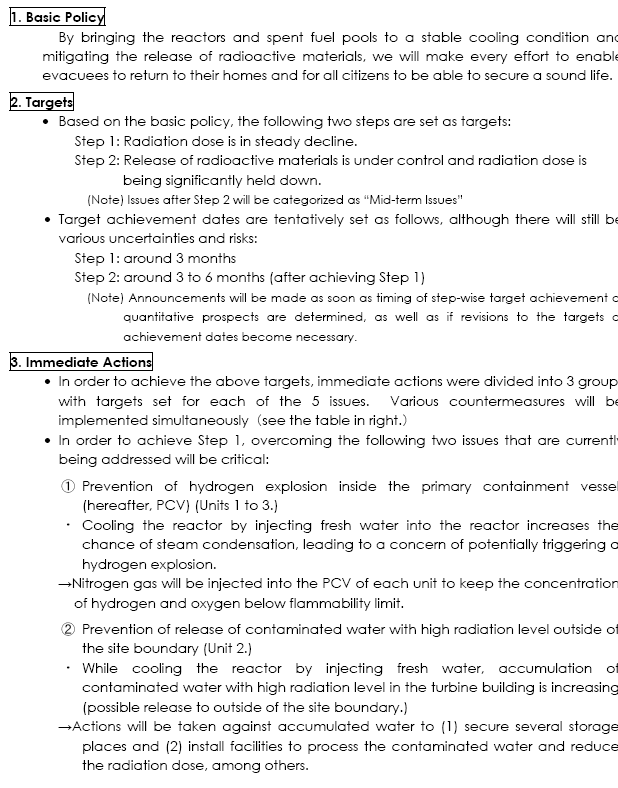
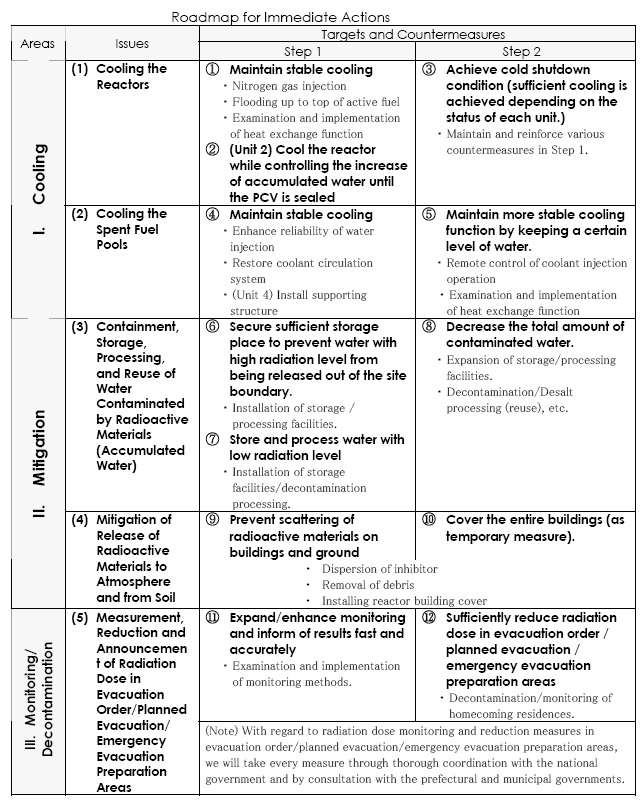
Credit:Tokyo Electric Power Company (Tepco), Digital Globe, BBC ,IAEA, Russia Today
